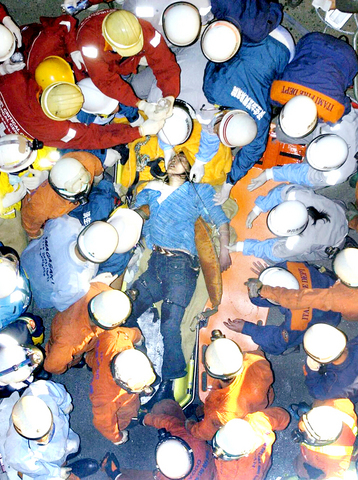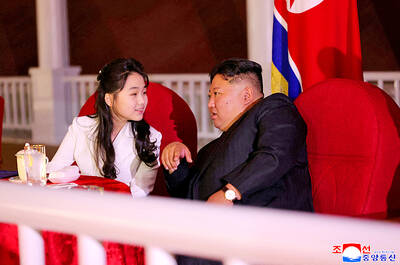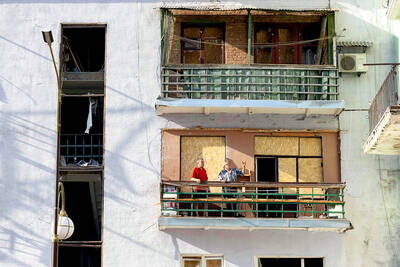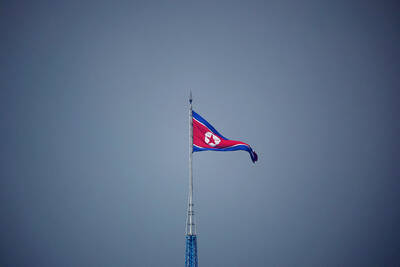Rescuers pulled the final survivors from the gnarled wreckage of Japan's worst train crash in decades yesterday as investigators raided rail operator offices for clues about why the train skidded from the tracks, killing 73 people.
Power shovels picked at the piles of twisted railway cars and debris, peeling away layers of crushed metal to allow better access to the two train cars flattened against an apartment building that the train slammed into during Monday's deadly accident in Amagasaki.
Agents swarmed eight offices of West Japan Railway Co, carting away cardboard boxes of documents, as media reports said the company's top executives were expected to resign. The probe into possible professional negligence has focused on the actions of the 23-year-old driver -- who has not yet been accounted for -- and the speed of the train.

PHOTO: AFP
Workers freed two survivors from the wreckage early yesterday, and police said they did not expect to find anyone else alive. Police wouldn't comment on media reports that workers had found at least 10 more people, all feared dead.
Hiroki Hayashi, 19, was sprung from a damaged car after surviving the night with the help of an intravenous drip and drinking water.
"I'm in pain, I can't take it anymore," he told his mother in a cell phone call after the crash, according to his 18-year-old brother Takamichi Hayashi.
Hiroki Hayashi was injured in the leg and was conscious and in stable condition at a hospital as of yesterday afternoon.
Victims' relatives struggled to comprehend their loss.
"I wish it were only a nightmare," Hiroko Kuki, whose son Tetsuji was killed in the crash, told public broadcaster NHK. "I only saw him the night before ... I wish he were alive somewhere."
In northern Japan, the lead car of a passenger train jumped the tracks when it crashed into a trailer at a crossing at Nimori yesterday in the second derailment in two days. The trailer's driver was slightly hurt.
The seven-car train that crashed Monday in Amagasaki was packed with 580 passengers when it jumped the tracks near this Osaka suburb and plunged into the first floor of an apartment complex. At least 456 people were injured.
About 10 government inspectors launched their accident investigation yesterday by examining tracks. They also planned to recover a recorder with data on the train's speed and other details at the time of the accident, said Mr. Shimoda, a Transportation Ministry inspector who gave only his family name.
Monday's accident occurred at a curve after a straightaway. Passengers speculated that the driver may have been speeding to make up for lost time after overshooting the previous station.
The train was nearly two minutes behind schedule, company officials said.
The driver -- identified as Ryujiro Takami -- had obtained his train operator's license in May last year. One month later, he overran a station and was issued a warning for his mistake, railway officials and police said.
They were investigating the case as possible professional negligence by the train operator, West Japan Railway Co, a prefectural police spokesman said on condition of anonymity.
JR West president, Takeshi Kakiuchi, and other top executives were likely to announce their resignation today at a board of directors' meeting originally scheduled to discuss earnings, the Nihon Keizai reported.
Tsunemi Murakami, the JR West safety director, said he instructed company employees to "fully cooperate" with police investigation to look into the cause of the accident.
"We take it seriously because of a large accident like this," he said.
Deadly train accidents are rare in Japan. Monday's accident was the worst rail disaster in nearly 42 years in safety-conscious Japan, which is home to one of the world's most complex, efficient and heavily traveled rail networks. A three-train crash in November 1963 killed 161 people in Tsurumi, outside Tokyo.

‘HYANGDO’: A South Korean lawmaker said there was no credible evidence to support rumors that Kim Jong-un has a son with a disability or who is studying abroad South Korea’s spy agency yesterday said that North Korean leader Kim Jong-un’s daughter, Kim Ju-ae, who last week accompanied him on a high-profile visit to Beijing, is understood to be his recognized successor. The teenager drew global attention when she made her first official overseas trip with her father, as he met with Chinese President Xi Jinping (習近平) and Russian President Vladimir Putin. Analysts have long seen her as Kim’s likely successor, although some have suggested she has an older brother who is being secretly groomed as the next leader. The South Korean National Intelligence Service (NIS) “assesses that she [Kim Ju-ae]

In the week before his fatal shooting, right-wing US political activist Charlie Kirk cheered the boom of conservative young men in South Korea and warned about a “globalist menace” in Tokyo on his first speaking tour of Asia. Kirk, 31, who helped amplify US President Donald Trump’s agenda to young voters with often inflammatory rhetoric focused on issues such as gender and immigration, was shot in the neck on Wednesday at a speaking event at a Utah university. In Seoul on Friday last week, he spoke about how he “brought Trump to victory,” while addressing Build Up Korea 2025, a conservative conference

DEADLOCK: Putin has vowed to continue fighting unless Ukraine cedes more land, while talks have been paused with no immediate results expected, the Kremlin said Russia on Friday said that peace talks with Kyiv were on “pause” as Ukrainian President Volodymyr Zelenskiy warned that Russian President Vladimir Putin still wanted to capture the whole of Ukraine. Meanwhile, US President Donald Trump said that he was running out of patience with Putin, and the NATO alliance said it would bolster its eastern front after Russian drones were shot down in Polish airspace this week. The latest blow to faltering diplomacy came as Russia’s army staged major military drills with its key ally Belarus. Despite Trump forcing the warring sides to hold direct talks and hosting Putin in Alaska, there

North Korea has executed people for watching or distributing foreign television shows, including popular South Korean dramas, as part of an intensifying crackdown on personal freedoms, a UN human rights report said on Friday. Surveillance has grown more pervasive since 2014 with the help of new technologies, while punishments have become harsher — including the introduction of the death penalty for offences such as sharing foreign TV dramas, the report said. The curbs make North Korea the most restrictive country in the world, said the 14-page UN report, which was based on interviews with more than 300 witnesses and victims who had